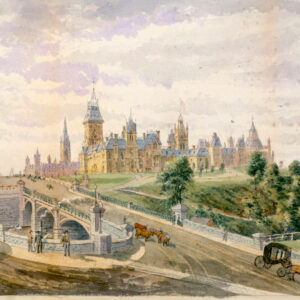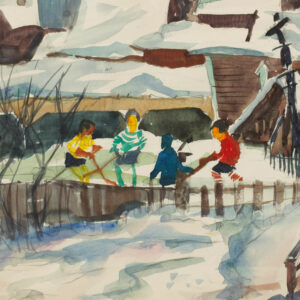-
MacCarthy, Hamilton (Canadian, 1846–1939)
A pioneer of early monumental bronze sculpture in Canada, MacCarthy studied sculpture under his father, Hamilton W. MacCarthy, and at the RA Schools in London. MacCarthy designed numerous Boer War memorials in Ottawa, Quebec City, Brantford, Halifax, Canning, and Charlottetown. Other major works include his statue of Samuel de Champlain, 1915, at Nepean Point, Ottawa, and the South African War Memorial, 1902, in Confederation Park, Ottawa.
-
MacLeod, Pegi Nicol (Canadian, 1904–1949)
A member of the Canadian Group of Painters, Nicol was a modernist painter whose work depicted energetic, vibrant scenes from the environments around her. She was known as Pegi Nicol MacLeod after 1937.
-
Manet, Édouard (French, 1832–1883)
Considered a forerunner of the modernist movement in painting, Manet eschewed traditional subject matter for depictions of contemporary urban life that incorporated references to classic works. Although his work was critically dismissed, his unconventional painting style influenced the Impressionists.
-
Masson, Henri (Belgian/Canadian, 1907–1996)
Masson emigrated from Belgium to Canada as a teenager. In his early professional life he worked as an engraver, painting in the evenings. His first solo exhibition of paintings was at the Picture Loan Society in 1934. He exhibited internationally, and today his work is held in major institutions in Canada, including the Vancouver Art Gallery; Art Gallery of Ontario, Toronto; and National Gallery of Canada, Ottawa.
-
May, (Henrietta) Mabel (Canadian, 1877–1971)
A modernist painter of landscapes, urban scenes, and portraits and figure paintings of women. May studied under William Brymner at the Art Association of Montreal, before spending time in Britain and France in 1912–13. After her return to Canada she was commissioned by the Canadian War Memorials Fund to depict women workers in munitions factories. May was an active member of Montreal’s Beaver Hall Group in the early 1920s and a founder of the Canadian Group of Painters in 1933.
-
Mayerovitch, Harry “Mayo” (Canadian, 1910–2004)
An architect, artist, illustrator, author, and cartoonist, Mayerovitch was a graduate of the School of Architecture at McGill University and the artistic director of the Wartime Information Board’s Graphic Arts Division. From 1942 to 1944, Mayerovitch designed propaganda posters in support of Canadian wartime efforts during the Second World War.
-
McCurry, H.O. (Canadian, 1889–1964)
An avid collector and advocate for the arts and art education in Canada, H.O. McCurry was patron to artist Tom Thomson and close with members of the Group of Seven. He was the assistant director of the National Gallery of Canada, Ottawa, from 1919 to 1939, and succeeded Eric Brown as director from 1939 to 1955.
-
McEwen, Jean (Canadian, 1923–1999)
Although he painted with the gestural and impasto techniques of the Automatistes, McEwen is properly called a post-Automatiste painter because of the more structured and rigorous procedures of his signature all-over surfaces of texture and variegated hues. In Paris in 1952–53, he came under the influence of Jean-Paul Riopelle and Sam Francis, and with them discovered the work of Claude Monet.
-
McGillivray, Florence Helena (Canadian, 1864–1938)
A Whitby-based painter, educator, and decorative artist recognized for her Post-Impressionist landscapes. McGillivray studied art in Toronto under British artist William Cruikshank and later in Paris, where she began to experiment with Post-Impressionist techniques. Upon her return to Canada, she lived in Ottawa for many years and produced accomplished landscape paintings of the Gatineau Hills and Valley. A leading artist of her time, McGillivray is thought to have had a formative influence on Tom Thomson’s work.
-
McLaren, Norman (Scottish/Canadian, 1914–1987)
McLaren began his career at General Post Office (GPO) in Scotland before following film producer John Grierson to the National Film Board in Canada. An innovative filmmaker, McLaren created abstract and animated films and experimented with techniques such as drawing directly on celluloid, cutout animation, and superimpositions. He created 72 films over the course of his career.
-
McMaster, Gerald (Plains Cree, Siksika First Nation, b. 1953)
An artist, educator, and curator, McMaster has worked at national and international institutions, including the National Museum of Man (now the Canadian Museum of History) in Canada and the Smithsonian National Museum of the American Indian in the United States. His artwork, which juxtaposes contemporary pop culture and traditional elements, has been exhibited at the Winnipeg Art Gallery, the McMichael Canadian Art Collection, and SITE Santa Fe, among others.
-
McMaster, Meryl (Plains Cree/Euro-Canadian, b.1988)
An Ottawa-based artist whose photographic self-portraits explore aspects of her personal identity, mixed Plains Cree and Euro-Canadian heritage, and relationship to the land. McMaster transforms her appearance using costumes, makeup, and props, conjuring fantastical personae that inhabit remote natural landscapes. Her work evokes personal and ancestral narratives, examines the effects of settler colonialism on the lives of Indigenous people and the natural environment, and considers how the past informs our understanding of the present.
-
Milne, David (Canadian, 1882–1953)
A painter, printmaker, and illustrator whose work—principally landscapes—displays the tonal brilliance and concern with process of his Impressionist and Post-Impressionist influences. Milne lived in New York early in his career, where he trained at the Art Students League and participated in the Armory Show in 1913.
-
Morris, Kathleen Moir (Canadian, 1893–1986)
A painter especially noted for her urban and rural subjects. Morris studied at the Art Association of Montreal under William Brymner and Maurice Cullen. Although she does not appear to have exhibited with the Beaver Hall Group in the early 1920s, she is closely associated with the group. Her paintings of scenery in Montreal and Quebec City, as well as her depictions of the ByWard Market in Ottawa, exemplify the interest that she and her contemporaries had in chronicling modern city life.
-
Morrisseau, Norval (Anishinaabe, 1931–2007)
A painter known for depicting Anishinaabe legends and personal, hybrid spiritual themes with vibrant colours and strong lines, Morrisseau was a crucial figure in introducing contemporary Indigenous art into the wider Canadian art scene. He founded the Woodland School and inspired a generation of younger First Nations artists. In 1978 Morrisseau was appointed to the Order of Canada, and in 2006 the National Gallery mounted a major retrospective of his work. (See Norval Morrisseau: Life & Work by Carmen Robertson.)
-
 About the Author
About the Author
Jim Burant is an Adjunct Professor of Art History at Carleton University, as well as Director of the Ontario Region of the National Archival Appraisal Board of Canada.
-
 More Online Art Books
More Online Art Books
Read online or download the ACI’s incredible library of art books for free in French and English.
Learn More -
 Read from Beginning
Read from Beginning
From a rough and tumble lumber town, Ottawa has become a vibrant metropolitan centre with a centre of artistic excellence.
Learn More
